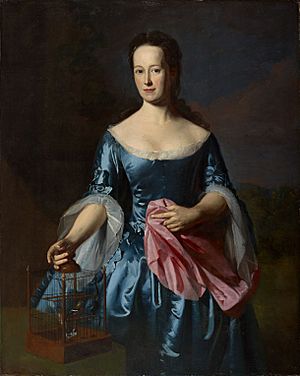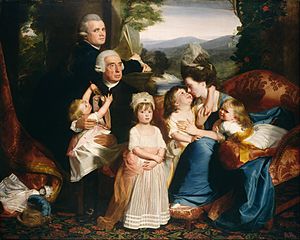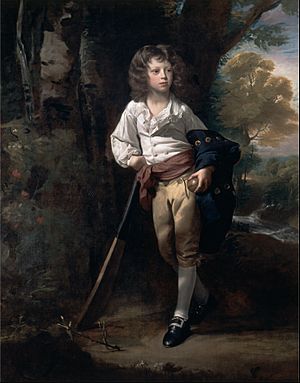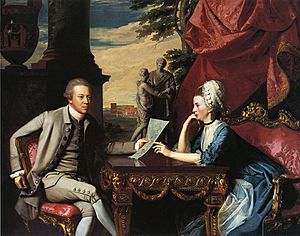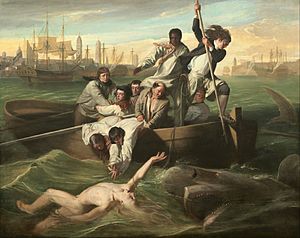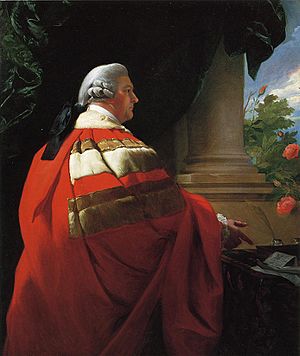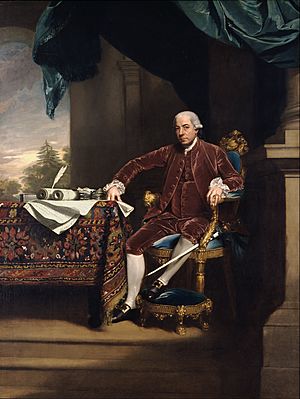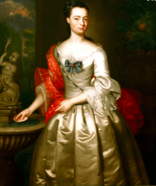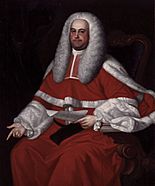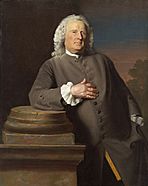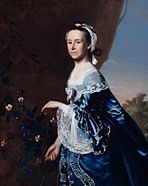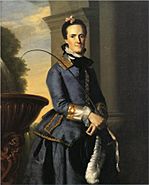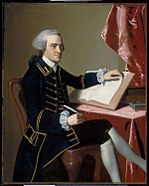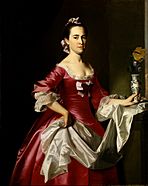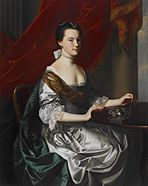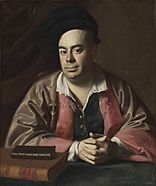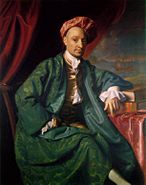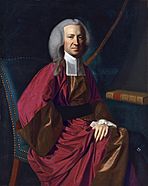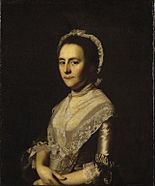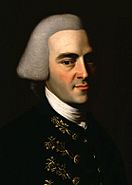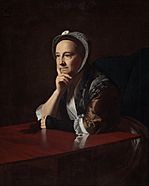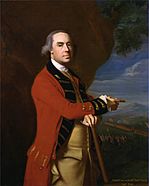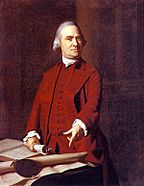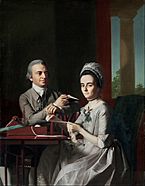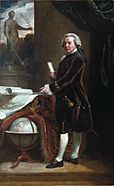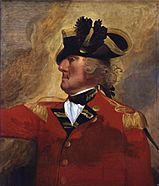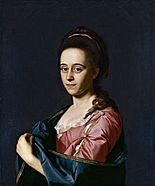John Singleton Copley facts for kids
Quick facts for kids
John Singleton Copley
|
|
|---|---|

|
|
| Born | July 3, 1738 |
| Died | September 9, 1815 (aged 77) London, England
|
| Education | Peter Pelham |
| Known for | Portraiture |
|
Notable work
|
Watson and the Shark (1778) |
John Singleton Copley (born July 3, 1738 – died September 9, 1815) was a famous painter from America and England. He was born in Boston, Massachusetts, and became a very successful portrait painter for rich people in colonial New England.
In 1774, he moved to London, England, and never came back to America. In London, he continued to paint many portraits. He also created large history paintings, which were special because they showed modern events and people in modern clothes. His later years were not as successful, and he died with many debts. He was the father of John Copley, 1st Baron Lyndhurst.
Contents
John Singleton Copley's Life
His Early Years
Copley's mother owned a tobacco shop in Boston. His parents, Richard and Mary Singleton Copley, came to Boston in 1736. They were involved in trade, like most people in the American colonies back then. His father was from Limerick, Ireland, and his mother was from a family in County Clare. Richard Copley was not well when he arrived in America and went to the West Indies, where he passed away.
We don't know much about Copley's early schooling, but he was said to be good at drawing from a young age. His letters show he was well-educated. He might have learned from his future stepfather, Peter Pelham. Pelham painted portraits, made engravings, and taught writing and math. Copley's mother married Peter Pelham in 1748. Young Copley likely learned to paint and engrave in their home.
Some people, including Copley's son, said he was completely self-taught and didn't see good art until he was nearly 30. Copley himself complained that there were "no examples of Art" in America. However, he probably saw some good paintings and many prints in Boston. His amazing portraits weren't accidental. A book of his drawings at the British Museum shows that he studied human figures carefully before he was 20. He likely learned his trade early because of the many skilled craftspeople in Boston.
Becoming a Famous Artist
Copley was about 14 when he painted his earliest known portrait, a picture of his half-brother Charles Pelham. It was very good for such a young artist. At 15, he painted the portrait of Rev. William Welsteed and even made prints of it to sell, following his stepfather's practice. He also painted a self-portrait around age 17 and a painting called Mars, Venus and Vulcan in 1754. These early works showed his talent.

Copley became a professional portrait painter even before he was an adult. In 1757, Captain Thomas Ainslie from Halifax was very happy with his portrait and suggested Copley visit Nova Scotia. Copley replied that he was too busy, with "a large Room full of Pictures unfinished."
Besides oil paintings, Copley was also a pioneer in using pastels in America. In 1762, he wrote to a Swiss painter asking for "the best Swiss Crayons for drawing of Portraits." He hoped that America, which had been a place of war, would one day become a "School of fine Arts." He used these pastels to create many portraits, showing his skill in capturing textures and emotions.
Copley became famous in England in 1766 when his painting A Boy with a Flying Squirrel was shown. It showed his half-brother, Henry Pelham, with a pet squirrel. This painting made Copley a member of the Society of Artists of Great Britain. The painting was sent to England without a name, and when Benjamin West saw it, he supposedly exclaimed, "What delicious coloring worthy of Titian himself!" The American squirrel helped him guess where the painting came from. West encouraged Copley to visit Europe to improve his art.
West's letters made Copley feel unhappy with his situation in Boston. Copley complained that he hadn't seen a truly good painting in America. However, he was cautious about leaving his good life in Boston. He earned about 300 Guineas a year, which was a lot of money in America. He worried about his "tender Mother and a Young Brother whose dependence is intirely upon me." West assured him that he had nothing to lose by coming to London.
Copley's income from painting made him part of the local upper class. Important people in New England came to him for portraits. In 1769, he married Susanna Farnham Clarke, whose father was a very rich agent for the Honourable East India Company. Her mother's family had come on the Mayflower. Their marriage was happy, and Susanna was a beautiful woman, seen in many of Copley's paintings.
Copley bought land on Beacon Hill and built a house there. The Copleys had six children and lived with several enslaved servants. Here, he painted portraits of important leaders, elegant women, and charming children. Their lifestyle showed they were wealthy. A student named John Trumbull visited Copley in 1771 and was impressed by his "crimson velvet" suit and elegant home.
Copley tried to stay out of politics, saying it was "neither pleasing to an artist or advantageous to the Art itself." However, he did sign a petition in 1771 to move a powder house from the town. In 1772, he was asked to design a new meeting-house for his church, and his grand plan was admired but not chosen because it was too expensive. He sympathized with the American independence movement but didn't actively join it.
Copley also painted portraits in New York City. In 1768, he painted Myles Cooper, the president of King's College, who invited him to New York. Between June 1771 and January 1772, Copley painted 37 portraits in New York. He wrote to his half-brother Henry Pelham, who was managing his affairs in Boston, describing his journey and his impressions of New York, which had "more Grand Buildings than Boston." He also gave detailed instructions for building a new house on his Beacon Hill property.
In September 1771, Copley and his wife visited Philadelphia, where they saw famous paintings. They also saw pictures believed to be by van Dyck in New Brunswick, New Jersey. Copley finished his work in New York by Christmas 1771. He never painted in the South.
His friends in England kept telling Copley to study in Europe. One person wrote that people in England were "enrapture'd with him, he is compared to Vandyck, Reubens and all the great painters of Old." His brother-in-law and Benjamin West also encouraged him to come.
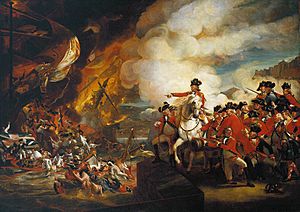
Boston was becoming very troubled politically. Copley's father-in-law was the merchant who received the tea that led to the Boston Tea Party. Copley's family connections were all Loyalists, meaning they supported the British. In 1773, he defended his wife's relatives. In 1774, a mob visited his house, looking for a Loyalist friend. Copley was worried about his family's safety.
Moving to London and European Travels
With many introduction letters, Copley sailed from Boston in June 1774. He left his mother, wife, and children with Henry Pelham. He arrived in London in July and quickly met Benjamin West, who he found to be a wonderful friend and artist. West and Copley together created a new type of history painting in England, showing modern events with great detail. Copley also met Joshua Reynolds and visited the Royal Academy.
On September 2, 1774, Copley arrived in Paris, starting a nine-month trip around Europe. He carefully described many paintings and sculptures. He traveled to Rome with another artist named Carter, who Copley found difficult. Carter wrote negative things about Copley, saying he complained about French firewood and bragged about future American art. Copley described Carter as a "snail which crawled over a man in his sleep and left its slime."
Copley reached Rome on October 26, 1774. He was excited to see the celebrations for the new Pope and the "Holy Year." He visited Naples in January 1775, but found the city dirty. He was very interested in the ancient city of Pompeii. In Rome, he copied famous paintings for clients.
Around May 1775, he traveled north through cities like Florence, Venice, and Cologne. From Parma, he urged Henry Pelham to bring his family to Europe because he feared Boston would be attacked. His anxiety was unnecessary, as his wife and children had already sailed from Marblehead in May 1775, arriving in London before Copley returned. Copley happily reunited with his family and set up his studio in London.
As an English painter, Copley's career started well. His painting skills were strong, and his reputation from America was amazing. He often said, however, that he couldn't surpass some of his earlier American works. Still, many of his "English Copleys" are beautiful paintings.
Following other artists, Copley began to paint historical scenes. His first big historical painting was Watson and the Shark. It showed a real event where Brook Watson was attacked by a shark in Havana harbor when he was 14. Watson, who became successful despite losing his leg, likely asked Copley to paint this to show that people can overcome even terrible difficulties. Prints of this painting became very popular.
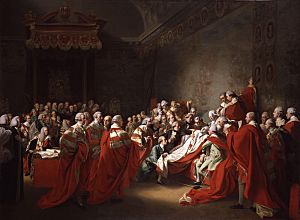
Copley also painted a large family portrait for his dining room, which critics later said was as good as paintings by Vandyck. But his fame as a historical painter came from The Death of the Earl of Chatham. This painting showed the former Prime Minister, William Pitt, 1st Earl of Chatham, collapsing in the House of Lords. The president of the Royal Academy, Sir William Chambers, criticized Copley for showing the painting privately before the academy's exhibition. Copley was angry but wisely decided not to reply. Prints of the Chatham painting sold very well in both England and America.
Copley put a lot of effort into his historical paintings, making sure to get good likenesses of people and correct details from the time period. He traveled around England to study old portraits and places. He painted other historical works like The Red Cross Knight, Abraham Offering up Isaac, The Death of Major Peirson, and The Siege of Gibraltar. He also continued to paint portraits of royal family members and many famous British and American people. Between 1776 and 1815, he sent 43 paintings to the Royal Academy exhibitions. He became an associate member in 1776 and a full member in 1783.
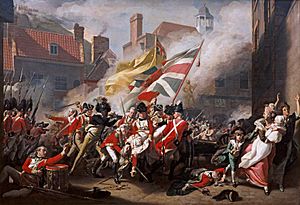
Copley worked very hard on his paintings, which sometimes affected his health and mood. His granddaughter said he usually painted from early morning until evening. In the evenings, his wife or daughter would read to him. He didn't get much exercise.
He wanted to return to America but his work kept him in England. He was more liberal in his political views than his relatives. In 1782, after King George III formally recognized American independence, Copley painted the Stars and Stripes flag on a ship in the background of a portrait. This was likely the first American flag painted in England. Copley stayed in touch with people from New England. He painted portraits of John Adams and John Quincy Adams when they visited England. He was also made an honorary member of the American Academy of Arts and Sciences in 1791.
In 1800, his daughter Elizabeth married Gardiner Greene of Boston, a wealthy man whose family kept many of Copley's letters. Before this marriage, Copley had sold his Beacon Hill estate in Boston. He felt cheated when he learned that the buyers knew the Massachusetts State House was planned for the top of the hill. He sent his son, John Singleton Copley, Jr., to Boston in 1796 to try and cancel the sale, but he was unsuccessful.
Later Years and Death
In his last 15 years, Copley painted constantly but felt much sadness and disappointment. The Napoleonic Wars made times tough. His home in London was expensive to keep up, and his son's education was costly. It saddened him that he had to rely on his son for financial help. He was also upset that his Equestrian Portrait of the Prince Regent didn't earn him money, and other paintings he spent years on remained unsold.
Copley's physical and mental health declined. In 1810, he had a bad fall. He constantly worried about losing his Boston property. His wife wrote in 1810 that he felt this loss more because life in England was getting harder, and his painting profession was earning less. In 1811 and 1812, he asked for more loans. By 1813, his wife reported that he was still painting but "cannot apply himself as closely as he used to do."
In June 1815, the Copleys hosted John Quincy Adams and happily discussed the new peace between the United States and the United Kingdom. Soon after, Copley had a paralytic stroke while at dinner. He seemed to get better at first, but then had a second stroke and died on September 9, 1815. His daughter Mary wrote that he was "perfectly resigned, and willing to die." He was buried in Croydon Minster in Croydon, Surrey.
Copley had fallen deeply into debt in his final years. His wife wrote in 1816 that after selling everything, there would still be a "large deficiency." His son, who later became Lord Lyndhurst, settled the estate, supported his mother, and kept many of his father's unsold paintings until they were auctioned in 1864. Many of these works are now in American art collections.
Copley's Legacy
Art experts say Copley was the most important and influential painter in colonial America. He created about 350 works of art. His amazing ability to capture realistic likenesses of people and things helped define a style of realistic art in America. His influence continued throughout the 1800s.
In Britain, he continued to paint portraits for important people. His great achievement was developing modern history painting, which combined reporting, grand ideas, and drama. He also was one of the first artists to hold private exhibitions, selling prints of his work to many people who might not have visited art shows before.
Places named after him include Copley Square, Copley Square Hotel, and Copley Plaza in Boston. There's also Copley Township, Summit County, Ohio, and a crater on Mercury called Copley. In 1965, the U.S. Postal Service issued a 5-cent stamp honoring John Singleton Copley, featuring his daughter Elizabeth Clark Copley from his painting Portrait of the Copley family (1776).
Selected Works
-
James Warren (1763)
-
Mrs. John Amory (c. 1763)
-
Thomas Hancock (1764–66)
-
John Hancock (1765)
-
John Hancock (ca 1770–72)
-
Paul Revere (1768)
-
Thomas Gage (1768)
-
Margaret Kemble Gage (c. 1771)
-
Samuel Adams (1772)
-
Mr. and Mrs. Thomas Mifflin (Sarah Morris) (1773)
-
John Adams (1783)
See Also
 In Spanish: John Singleton Copley para niños
In Spanish: John Singleton Copley para niños


